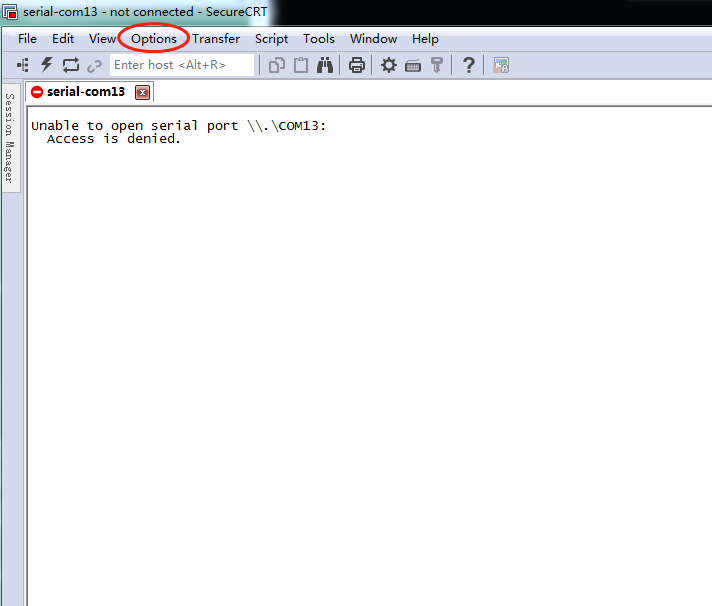

utility as described here online to save all of your Global, Session, etc.
#SECURECRT CONFIG FILE UPGRADE#
If you're running SecureCRT version 7.3 or newer, the best way to be prepared for an OS upgrade is probably to use the Tools > Export Settings. this folder), you should now see all of your settings that you had before you made this original change. If you pointed the Global setting to your prior configuration folder (and you haven't deleted/modified/etc. If you want to get back to your complete (new) config, edit the Global Options setting and point it back to the location it was set to before you changed it then restart SecureCRT. All that's done by changing the Global Options setting is tell SecureCRT where to look to read in its config once you've closed SecureCRT and started it again. Parser.add_argument('files', type=argparse.When you change the configuration path in Global Options, SecureCRT doesn't move/copy any of your configuration settings. Parser = argparse.ArgumentParser(description='Tool to decrypt SSHv2 passwords in VanDyke Secure CRT session files') REGEX_USERNAME = re.compile(ur'S:"Username"=(*)') REGEX_PASWORD = re.compile(ur'S:"Password"=u(+)') REGEX_HOSTNAME = re.compile(ur'S:"Hostname"=(*)') Padded = c1.decrypt(c2.decrypt(code('hex'))) # C:\>python SecureCRT-decryptpass.py C:\Users\user1\AppData\Roaming\VanDyke\Config\Sessions\192.168.0.1.ini # -h, -help show this help message and exit #Tool to decrypt SSHv2 passwords in VanDyke Secure CRT session files Print(SecureCRTCrypto().Decrypt(Ciphertext)) Print(SecureCRTCryptoV2(ConfigPassphrase).Decrypt(Ciphertext)) Print(SecureCRTCrypto().Encrypt(Plaintext))ĭef DecryptionRoutine(UseV2 : bool, ConfigPassphrase : str, Ciphertext : str): Print(SecureCRTCryptoV2(ConfigPassphrase).Encrypt(Plaintext)) Print(' NOTICE: Ciphertext string must be a hex string.')ĭef EncryptionRoutine(UseV2 : bool, ConfigPassphrase : str, Plaintext : str):

Print(' Plaintext string or ciphertext string.') Print(' The config passphrase that SecureCRT uses.') Print(' Encrypt/Decrypt with "Password V2" algorithm.') Print(' This parameter must be specified.') Print(' "enc" for encryption, "dec" for decryption.') If SHA256.new(plain_bytes).digest() != plain_bytes_digest: If len(plain_bytes_digest) != SHA256.digest_size:

If len(plain_bytes) != plain_bytes_length: Plain_bytes_length = int.from_bytes(padded_plain_bytes, 'little') Padded_plain_bytes = crypt(omhex(Ciphertext)) Return cipher.encrypt(padded_plain_bytes).hex() Os.urandom(AES.block_size - len(plain_bytes) % AES.block_size)Ĭipher = AES.new(self.Key, AES.MODE_CBC, iv = self.IV) Len(plain_bytes).to_bytes(4, 'little') + \ Raise OverflowError('Plaintext is too long.') Return cipher1.encrypt(os.urandom(4) + cipher2.encrypt(padded_plain_bytes) + os.urandom(4)).hex()ĭecrypt ciphertext and return corresponding plaintext.Ĭiphertext: A hex string that will be decrypted.Ĭiphered_bytes = omhex(Ciphertext) Padded_plain_bytes = plain_bytes + os.urandom(Blowfish.block_size - len(plain_bytes) % Blowfish.block_size)Ĭipher1 = Blowfish.new(self.Key1, Blowfish.MODE_CBC, iv = self.IV)Ĭipher2 = Blowfish.new(self.Key2, Blowfish.MODE_CBC, iv = self.IV) Plain_bytes = Plaintext.encode('utf-16-le') Plaintext: A string that will be encrypted. SecureCRTCipher.py #!/usr/bin/env python3 #python3 SecureCRT-decryptpass.py 127.0.0.1.ini # python3 SecureCRTCipher.py dec -v2 hash 7.X, remove the first "u" in the head of password:Ĩ.X, remove the three character such as "02:" at the begin of password: ini file, some Chinese guy said it could.
#SECURECRT CONFIG FILE PASSWORD#
Although official said it can't Recover Password from.


 0 kommentar(er)
0 kommentar(er)
